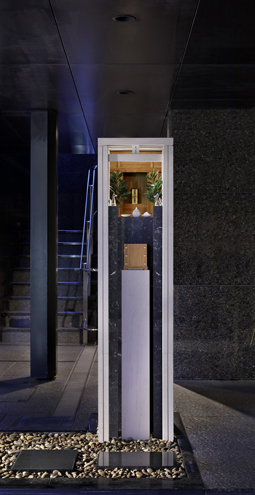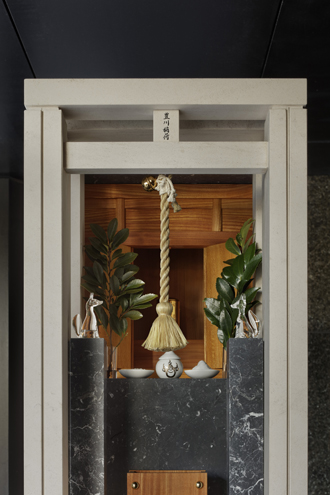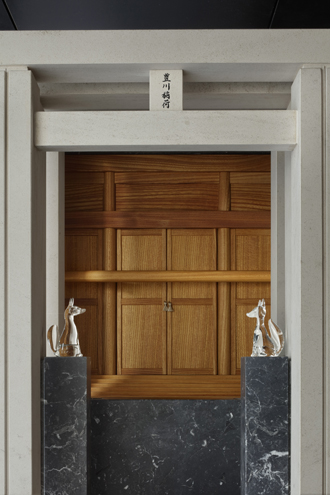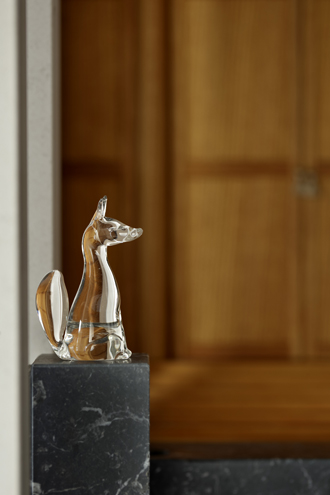八重洲に祀られていた豊川稲荷の小さな祠を麹町にあるオフィスビルに移す際、依頼を受けました。外資系のテナントが多いビルのオーナーから、「違う宗教の方も多いので、あまり目立たないようにしたい」との要望があり、道路、エントランス側からは石のモニュメントのように見え、側面に回り込まないと祠とわからない意匠になっています。
豊川さんは神社ではなく寺院という衝撃の事実もあり、基礎となる様式の整理に苦労しましたが、根源的と思える部分を取捨選択してまとめていきました。仏様なので鳥居の形式はあまり気にせず、日本古来の“白狐”は透明な生き物だったのでガラスで表現するといった具合です。本殿は豊川稲荷東京別院の意匠をもとにオーナーの趣味を汲み民芸調に仕上げています。ぱっと見、エキセントリックかもしれませんが、いたって保守的なデザイン手法で成立しています。
The project came about as a tiny shrine of Toyokawa Inari in Yaesu had to be relocated to an office building in Kojimachi. As the building housed tenants of many multinational companies, the owner’s request was “to make it as inconspicuous as possible as there are people of different faiths working in the building.” The final structure looks like a simple stone monument from the entrance of the building and only becomes recognizable as a shrine as you go around to its side.
A shocking revelation that Toyokawa Inari was not a Shinto shrine but a Buddhist temple(in Japan, distinction between Shinto spirit and Buddha is sometimes blurred) caused a rethink of how to sort basic designs but we picked what we considered fundamental and combined them during the designing process: we did not pay too much attention to the structure of the torii gate as it is not an essential part of the Buddhist architecture; “the white fox”, which was a servant and messenger of the Inari kami, was an invisible being so we chose glass as its material. For the inner sanctuary, we used the Tokyo branch of Toyokawa Inari as a motif and added a folk art feel at the request of the building’s owner. It may look eccentric at a first glance but the whole designing process was based on very traditional technique.
原本奉祀于八重洲的小神殿丰川稻荷,搬迁到曲町的办公大楼时,业主前来委托设计。大楼内多是外资企业进驻,大楼业主希望「宗教信仰多有不同,所以不要过于醒目突兀」。因此,整体设计,从道路、入口处看来,神殿像是一座石造纪念碑,必须绕到侧边才会发现这座神殿。
透过这次的设计,才惊觉发现丰川稻荷不是神社,而是寺院,所以花费不少心力,从头研究样式,撷取根源部分,归纳设计完成。因为丰川稻荷属于佛教,就无需拘泥鸟居的形式;自古以来,日本的「白狐」是透明的生物,所以藉由玻璃表现。正殿则以丰川稻荷东京别院的设计为本,再加入大楼业主的品味,最后呈现出民间工艺的风格。乍看之下,或许飘荡着奇特氛围,其实设计手法十分保守。













